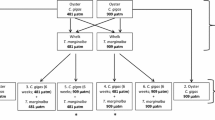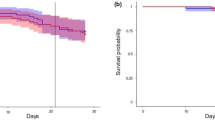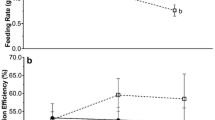Abstract
As ocean temperatures continue to rise due to climate change, many questions remain on how coastal species will cope with a changing environment. The effects of increased temperatures on bivalves has been well examined through single-species studies, showing reductions in tissue mass, shell growth, oxygen uptake, feeding rates, and survival. However, the consequences of these effects on predator–prey interactions remain poorly understood. We examined how increased temperatures (30, 32, 34 °C) and the presence of water-borne predation cues from blue crabs (Callinectes sapidus) affected the morphology and growth rate of southern ribbed mussels (Geukensia granosissima), as well as their handling times when attacked by predatory crabs. Although southern ribbed mussels were able to survive under chronic heat stress, exposure to higher temperatures resulted in more elongated shell shapes. Growth rates in mussel wet weight were higher for mussels reared in the presence of a predator than in the predator-free control, but only in the low-temperature treatment. Likewise, handling times were greater for crabs eating mussels grown in the presence of a predator, but the effect was lost at the mid- and high-temperature treatments. These findings suggest that predation-induced defenses were suppressed when prey were under chronic thermal stress, which could make mussels more vulnerable to predation. The presence of predation cues in natural environments should be taken in consideration when estimating or predicting the effects of climate change on organisms.




Similar content being viewed by others
References
Bertness MD (1984) Ribbed mussels and Spartina alterniflora production in a New England salt-marsh. Ecology 65:1794–1807. https://doi.org/10.2307/1937776
Blundon JA, Kennedy VS (1982) Refuges for infaunal bivalves from blue crab, Callinectes sapidus (Rathbun), predation in Chesapeake Bay. J Exp Mar Biol Ecol 65:67–81. https://doi.org/10.1016/0022-0981(82)90176-9
Bronmark C, Lakowitz T, Hollander J (2011) Predator-induced morphological plasticity across local populations of a freshwater snail. PLoS One 6:6. https://doi.org/10.1371/journal.pone.0021773
Buckley BA, Owen M-E, Hofmann GE (2001) Adjusting the thermostat: the threshold induction temperature for the heat-shock response in intertidal mussels (genus Mytilus) changes as a function of thermal history. J Exp Biol 204:3571–3579
Caro AU, Castilla JC (2004) Predator-inducible defences and local intrapopulation variability of the intertidal mussel Semimytilus algosus in central Chile. Mar Ecol Prog Ser 276:115–123. https://doi.org/10.3354/meps276115
Connell JH (1961) Effects of competition, predation by Thais lapillus, and other factors on natural populations of the barnacle Balanus balanoides. Ecol Monogr 31:61–104
Connell JH (1972) Community interactions on marine rocky intertidal shores. Annu Rev Ecol Syst 3:169–192. https://doi.org/10.1146/annurev.es.03.110172.001125
Davenport J, Davenport JL (2005) Effects of shore height, wave exposure and geographical distance on thermal niche width of intertidal fauna. Mar Ecol Prog Ser 292:41–50. https://doi.org/10.3354/meps292041
Elner RW, Hughes RN (1978) Energy maximization in the diet of the shore crab, Carcinus maenas. J Anim Ecol 47:103–116. https://doi.org/10.2307/3925
Environmental Protection Commission of Hillsborough County (2018) EPC Water Quality Data, Tampa. http://www.epchc.org/divisions/water-management/water-monitoring-maps-and-data. Accessed 18 May 2018
Fields PA, Cox KM, Karch KR (2012) Latitudinal variation in protein expression after heat stress in the salt marsh mussel Geukensia demissa. Integr Comp Biol 52:636–647. https://doi.org/10.1093/icb/ics086
Fitzgerald-Dehoog L, Browning J, Allen BJ (2012) Food and heat stress in the California Mussel: evidence for an energetic trade-off between survival and growth. Biol Bull 223:205–216
Freeman AS (2007) Specificity of induced defenses in Mytilus edulis and asymmetrical predator deterrence. Mar Ecol Prog Ser 334:145–153
Freeman AS, Byers JE (2006) Divergent induced responses to an invasive predator in marine mussel populations. Science 313:831–833. https://doi.org/10.1126/science.1125485
Ganser AM, Newton TJ, Haro RJ (2015) Effects of elevated water temperature on physiological responses in adult freshwater mussels. Freshw Biol 60:1705–1716. https://doi.org/10.1111/fwb.12603
Gestoso I, Arenas F, Olabarria C (2015) Feeding behaviour of an intertidal snail: does past environmental stress affect predator choices and prey vulnerability? J Sea Res 97:66–74. https://doi.org/10.1016/j.seares.2014.12.006
Gestoso I, Arenas F, Olabarria C (2016) Ecological interactions modulate responses of two intertidal mussel species to changes in temperature and pH. J Exp Mar Biol Ecol 474:116–125. https://doi.org/10.1016/j.jembe.2015.10.006
Goodwin DH, Flessa KW, Schone BR, Dettman DL (2001) Cross-calibration of daily growth increments, stable isotope variation, and temperature in the Gulf of California bivalve mollusk Chione cortezi: implications for paleoenvironmental analysis. Palaios 16:387–398. https://doi.org/10.2307/3515578
Han GD, Zhang S, Marshall DJ, Ke CH, Dong YW (2013) Metabolic energy sensors (AMPK and SIRT1), protein carbonylation and cardiac failure as biomarkers of thermal stress in an intertidal limpet: linking energetic allocation with environmental temperature during aerial emersion. J Exp Biol 216:3273–3282. https://doi.org/10.1242/jeb.084269
Harper E, Skelton P (1993) A defensive value of the thickened periostracum in the Mytiloidea. Veliger 36:36–42
Helm MM, Bourne N, Lovatelli A (2004). Hatchery culture of bivalves — a practical manual. FAO Fisheries Technical Paper. FAO, Rome
Hofmann GE, Somero GN (1995) Evidence for protein damage at environmental temperatures—seasonal changes in levels of ubiquitin conjugates and HSP70 in the intertidal mussel Mytilus trossulus. J Exp Biol 198:1509–1518
Hughes RN, Seed R (1981) Size selection of mussels by the blue crab Callinectes sapidus: energy maximizer or time minimizer? Mar Ecol Prog Ser 6:83–89. https://doi.org/10.3354/meps006083
Hughes RN, Seed R (1995) Behavioural mechanisms of prey selection in crabs. J Exp Mar Biol Ecol 193:225–238. https://doi.org/10.1016/0022-0981(95)00119-0
Jones D (2014) Fathom Toolbox for Matlab: software for multivariate ecological and oceanographic data analysis. College of Marine Science, University of South Florida, St Petersburg
Jost J, Helmuth B (2007) Morphological and ecological determinants of body temperature of Geukensia demissa, the Atlantic ribbed mussel, and their effects on mussel mortality. Biol Bull 213:141–151
Keppel EA, Scrosati RA, Courtenay SC (2015) Interactive effects of ocean acidification and warming on subtidal mussels and sea stars from Atlantic Canada. Mar Biol Res 11:337–348. https://doi.org/10.1080/17451000.2014.932914
Kordas RL, Harley CDG, O’Connor MI (2011) Community ecology in a warming world: the influence of temperature on interspecific interactions in marine systems. J Exp Mar Biol Ecol 400:218–226. https://doi.org/10.1016/j.jembe.2011.02.029
Kroeker KJ, Kordas RL, Crim R, Hendriks IE, Ramajo L, Singh GS, Duarte CM, Gattuso JP (2013) Impacts of ocean acidification on marine organisms: quantifying sensitivities and interaction with warming. Glob Change Biol 19:1884–1896. https://doi.org/10.1111/gcb.12179
Kroeker KJ, Gaylord B, Hill TM, Hosfelt JD, Miller SH, Sanford E (2014) The role of temperature in determining species’ vulnerability to ocean acidification: a case study using Mytilus galloprovincialis. PLoS One 9:10. https://doi.org/10.1371/journal.pone.0100353
Lopez MS, Coutinho R, Ferreira CEL, Rilov G (2010) Predator-prey interactions in a bioinvasion scenario: differential predation by native predators on two exotic rocky intertidal bivalves. Mar Ecol Prog Ser 403:101–112. https://doi.org/10.3354/meps08409
Macreadie PI, Geraldi NR, Peterson CH (2011) How small-scale variation in oyster reef patchiness influences predation on bivalves. Mar Ecol Prog Ser 429:87–91. https://doi.org/10.3354/meps09115
Meehl G, Stocker T, Collins W, Friedlingstein P, Gaye A, Gregory J, Kitoh A, Knutti R, Murphy J, Noda A, Raper S, Watterson I, Weaver A, Zhao Z (2007) Contribution of working group 1 to the fourth assessment report of the intergovernmental panel on climate change. Cambridge University, Cambridge
Miller LP, Matassa CM, Trussell GC (2014) Climate change enhances the negative effects of predation risk on an intermediate consumer. Glob Change Biol 20:3834–3844. https://doi.org/10.1111/gcb.12639
Nicholson S (2002) Ecophysiological aspects of cardiac activity in the subtropical mussel Perna viridis (L.) (Bivalvia: Mytilidae). J Exp Mar Biol Ecol 267:207–222. https://doi.org/10.1016/s0022-0981(01)00362-8
Noisette F, Richard J, Le Fur I, Peck LS, Davoult D, Martin S (2015) Metabolic responses to temperature stress under elevated pCO2 in Crepidula fornicata. J Mollus Stud 81:238–246. https://doi.org/10.1093/mollus/eyu084
Peterson CH, Grabowski JH, Powers SP (2003) Estimated enhancement of fish production resulting from restoring oyster reef habitat: quantitative valuation. Mar Ecol Prog Ser 264:249–264. https://doi.org/10.3354/meps264249
Pincebourde S, Sanford E, Helmuth B (2008) Body temperature during low tide alters the feeding performance of a top intertidal predator. Limnol Oceanogr 53:1562–1573. https://doi.org/10.4319/lo.2008.53.4.1562
Read KRH, Cumming KB (1967) Thermal tolerance of the bivalve molluscs Modiolus modiolus L., Mytilus edulis L. and Brachidontes demissus Dillwyn. Comp Biochem Physiol 22:149–155. https://doi.org/10.1016/0010-406X(67)90176-4
Reed Mariculture, Inc. (2015) Shellfish diet: smaller cell sizes & more DHA for first feeding larvae, Campbell
Roberts DA, Hofmann GE, Somero GN (1997) Heat-shock protein expression in Mytilus californianus: acclimatization (seasonal and tidal-height comparisons) and acclimation effects. Biol Bull 192:309–320. https://doi.org/10.2307/1542724
Robson AA, De Leaniz CG, Wilson RP, Halsey LG (2010) Behavioural adaptations of mussels to varying levels of food availability and predation risk. J Mollus Stud 76:348–353. https://doi.org/10.1093/mollus/eyq025
Rodland DL, Schone BR, Baier S, Zhang ZJ, Dreyer W, Page NA (2009) Changes in gape frequency, siphon activity and thermal response in the freshwater bivalves Anodonta cygnea and Margaritifera falcata. J Mollus Stud 75:51–57. https://doi.org/10.1093/mollus/eyn038
Schalkhausser B, Bock C, Portner HO, Lannig G (2014) Escape performance of temperate king scallop, Pecten maximus under ocean warming and acidification. Mar Biol 161:2819–2829. https://doi.org/10.1007/s00227-014-2548-x
Schiel DR, Steinbeck JR, Foster MS (2004) Ten years of induced ocean warming causes comprehensive changes in marine benthic communities. Ecology 85:1833–1839
Schöne B, Giere O (2005) Growth pattern and shell isotope ratios of the deep-sea hydrothermal vent bivalve mollusk Bathymodiolus brevior from the North Fiji Basin, Pacific Ocean. Deep Sea Res I 52:1896–1910
Schöne BR, Goodwin DH, Flessa KW, Dettman DL, Roopnarine PD (2002) Sclerochronology and growth of the bivalve mollusks Chione (Chionista) fluctifraga and C. (Chionista) cortezi in the northern Gulf of California, Mexico. Veliger 45:45–54
Schram JB, Schoenrock KM, McClintock JB, Amsler CD, Angus RA (2014) Multiple stressor effects of near-future elevated seawater temperature and decreased pH on righting and escape behaviors of two common Antarctic gastropods. J Exp Mar Biol Ecol 457:90–96. https://doi.org/10.1016/j.jembe.2014.04.005
Sherwood RM, Petraitis PS (1998) Mortality differences of two intertidal mussels, Mytilus edulis L. and Geukensia demissa (Dillwyn), in a New Jersey salt marsh. J Exp Mar Biol Ecol 231:255–265. https://doi.org/10.1016/s0022-0981(98)00095-1
Smith LD, Jennings JA (2000) Induced defensive responses by the bivalve Mytilus edulis to predators with different attack modes. Mar Biol 136:461–469. https://doi.org/10.1007/s002270050705
Sokolov AP et al (2009) Probabilistic forecast for twenty-first-century climate based on uncertainties in emissions (without policy) and climate parameters. J Clim 22:5175–5204. https://doi.org/10.1175/2009jcli2863.1
Somero GN (2002) Thermal limits to life: underlying mechanisms and adaptive plasticity. Integr Comp Biol 42:1316
Somero GN (2010) The physiology of climate change: how potentials for acclimatization and genetic adaptation will determine ‘winners’ and ‘losers’. J Exp Biol 213:912–920. https://doi.org/10.1242/jeb.037473
Talmage SC, Gobler CJ (2011) Effects of elevated temperature and carbon dioxide on the growth and survival of larvae and juveniles of three species of Northwest Atlantic bivalves. PLoS One 6:12. https://doi.org/10.1371/journal.pone.0026941
Tateda Y, Sakaguchi I, Itani G (2015) Scope for growth of Mytilus galloprovincialis and Perna viridis as a thermal stress index in the coastal waters of Japan: field studies at the Uranouchi inlet and Yokohama. J Exp Mar Biol Ecol 470:55–63. https://doi.org/10.1016/j.jembe.2015.03.021
Tomanek L, Zuzow MJ (2010) The proteomic response of the mussel congeners Mytilus galloprovincialis and M. trossulus to acute heat stress: implications for thermal tolerance limits and metabolic costs of thermal stress. J Exp Biol 213:3559–3574. https://doi.org/10.1242/jeb.041228
White JD, Hamilton SK, Sarnelle O (2015) Heat-induced mass mortality of invasive zebra mussels (Dreissena polymorpha) at sublethal water temperatures. Can J Fish Aquat Sci 72:1221–1229. https://doi.org/10.1139/cjfas-2015-0064
Wilbur AE, Hilbish TJ (1989) Physiological energetics of the ribbed mussel Geukensia demissa (Dillwyn) in response to increased temperature. J Exp Mar Biol Ecol 131:161–170. https://doi.org/10.1016/0022-0981(89)90005-1
Yamada SB, Navarrete SA, Needham C (1998) Predation induced changes in behavior and growth rate in three populations of the intertidal snail, Littorina sitkana (Philippi). J Exp Mar Biol Ecol 220:213–226
Zhao LQ, Schone BR, Mertz-Kraus R, Yang F (2017) Insights from sodium into the impacts of elevated pCO2 and temperature on bivalve shell formation. J Exp Mar Biol Ecol 486:148–154. https://doi.org/10.1016/j.jembe.2016.10.009
Acknowledgements
We are grateful to Kevin Stichnot and Zach Ostroff for their assistance in building the temperature-controlled experimental system used for this study and to Dr. David Jones (College of Marine Science, University of South Florida) and Dr. David Kimbro (Department of Earth and Environmental Science, Northeastern University) for their support in data analysis and experimental design. Many thanks also to Destiny Reese and Ethan Taylor for their technical support throughout the experimental period. We acknowledge Pinellas County Parks & Conservation Resources for providing permission to collect organisms from Weedon Island Preserve, Florida, USA. This material is based upon work supported by the National Science Foundation Graduate Research Fellowship (Award No. 1746051) and Florida-Georgia Louis Stokes Alliance for Minority Participation (FGLSAMP) Bridge to the Doctorate award (HRD No. 1139850). Any opinion, findings, and conclusions or recommendations expressed in this material are those of the author(s) and do not necessarily reflect the views of the National Science Foundation. Further funding was provided by the Alfred P. Sloan Foundation Minority Ph.D. (MPHD) Program (Grant No. 2012-3-07) and the University of South Florida, Bridge to the Doctorate Endowed Graduate Fellowship (Fund No. 266005). This work was supported, in part, by the University of South Florida Research & Innovation Internal Awards Program (Grant No. 0084477). Animal illustrations courtesy of the Integration and Application Network, University of Maryland Center for Environmental Science (ian.umces.edu/symbols/).
Author information
Authors and Affiliations
Corresponding author
Ethics declarations
Conflict of interest
The authors declare that they have no conflict of interest.
Statement of welfare of animals
All applicable international, national, and/or institutional guidelines for the care and use of animals were followed.
Additional information
Responsible Editor: A. Checa.
Reviewed by E. Cacabelos and undisclosed experts.
Rights and permissions
About this article
Cite this article
Freytes-Ortiz, I.M., Stallings, C.D. Elevated temperatures suppress inducible defenses and alter shell shape of intertidal mussel. Mar Biol 165, 113 (2018). https://doi.org/10.1007/s00227-018-3371-6
Received:
Accepted:
Published:
DOI: https://doi.org/10.1007/s00227-018-3371-6




